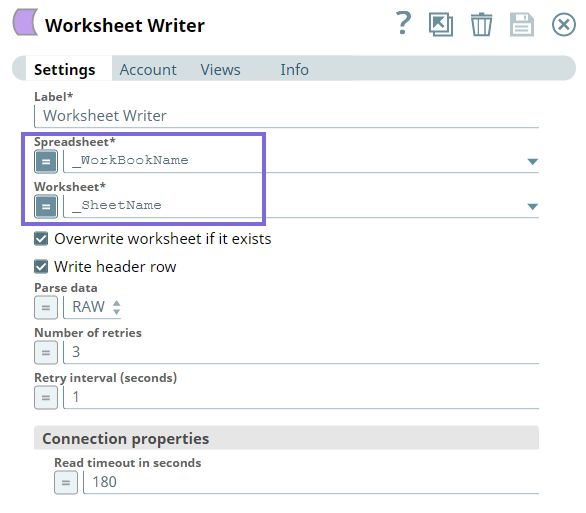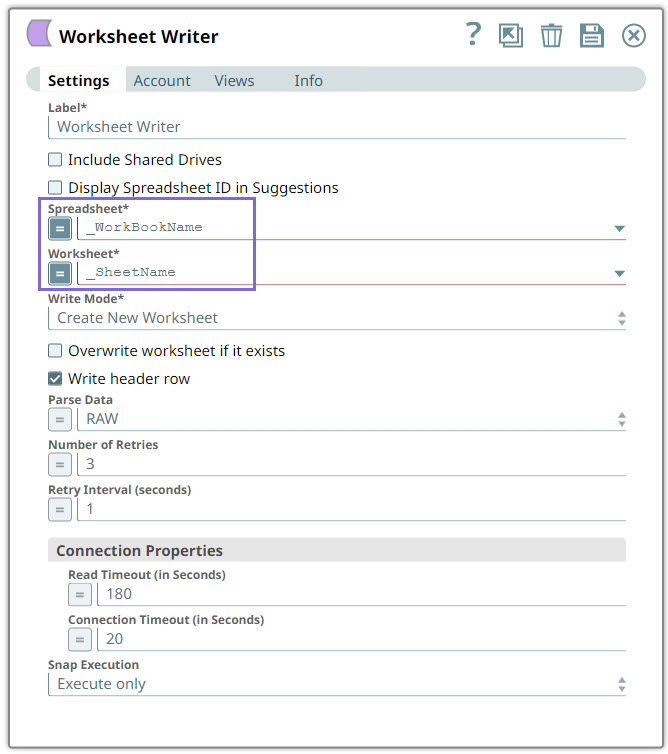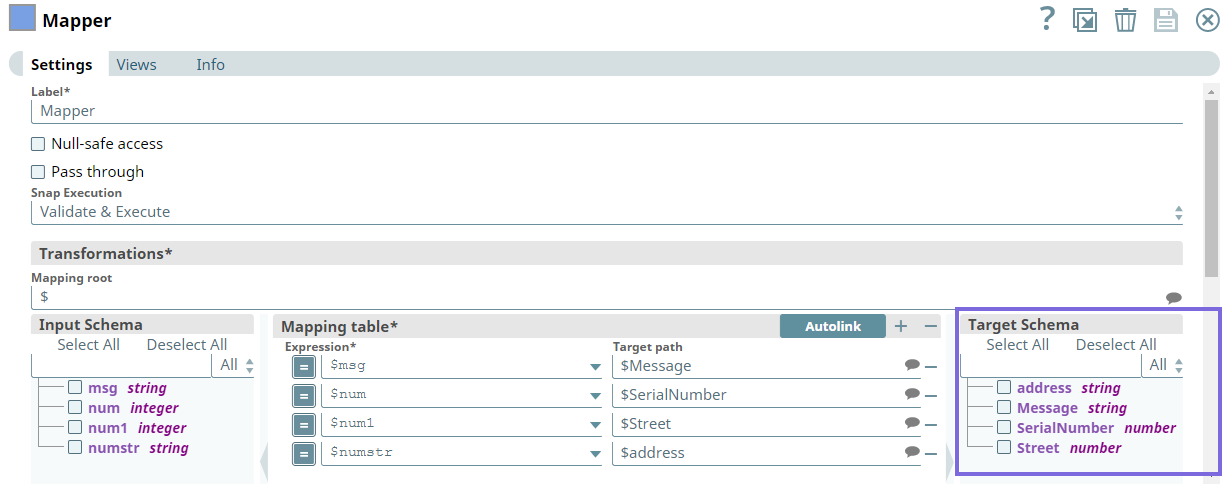On In this Pagearticle
| Table of Contents | ||||
|---|---|---|---|---|
|
Overview
You can use this Snap to write to a worksheet in a Google sheet.
| Note | ||||
|---|---|---|---|---|
| ||||
Enhances the Google Sheets Snap Pack by migrating from version 3 to 4 API as Google announces sunsetting the v3 API on June 8, 2021. For more information, see Migrating Google Sheets Pipelines from V3 to V4. |
Prerequisites
A valid Google Spreadsheet account.
Support for Ultra Pipelines
Works in Ultra Pipelines.
Limitations
- The Snap conforms to the limitations imposed by Google Drive service. A spreadsheet may contain multiple worksheets. The cell count limit applies to the sum of the cells in all the worksheets in a spreadsheet.
- If the spreadsheet or worksheet to which you want to write contains one or more leading or trailing spaces, the Worksheet Writer Snap does not function as expected:
- If the spreadsheet name contains leading or trailing spaces, the Snap displays a "
Spreadsheet not found" error. - If the worksheet name contains leading or trailing spaces, the Snap creates a new worksheet in the target spreadsheet using the worksheet name specified, without the extra space.
Workaround: Enclose the names of the spreadsheet and worksheet in quotes (") and enable expressions for both Spreadsheet and Worksheet fields.
- If the spreadsheet name contains leading or trailing spaces, the Snap displays a "
You cannot create a new Spreadsheet in shared drives using the Worksheet Writer Snap—the spreadsheet can only be overwritten.
You cannot write new Spreadsheets to any location except the default location (that is, the user’s root drive).
Once a Spreadsheet is available, you can modify and read it irrespective of the location by specifying the sheet name or sheet ID or both.
Known Issue
Multiexcerpt include macro name ME_GS_KI page Spreadsheets Browser
Snap
Input and OutputViews
| Type | Format | Number of Views | Examples of Upstream and Downstream Snaps | Description |
|---|---|---|---|---|
| Input | Document |
|
| The name of the worksheet and spreadsheet information to be written to. |
| Output | Document |
|
| Statistics (Number of records written successfully and number of invalid records.) |
| Error | Error handling is a generic way to handle errors without losing data or failing the Snap execution. You can handle the errors that the Snap might encounter while running the Pipeline by choosing one of the following options from the When errors occur list under the Views tab. The available options are:
Learn more about Error handling in Pipelines. | |||
Snap Settings
| Field Name | Field |
|---|
| Type | Description | |
|---|---|---|
Label* | ||
Default Value: Worksheet Writer | String | Specify the name for the Snap. You can modify this to be more specific, especially if you have more than one of the same Snap in your Pipeline. | |
Include Shared Drives Default Value: Deselected | Checkbox | Select this checkbox to write files from the shared drive. Deselect this checkbox if you do not want the Snap to write files from the shared drive. | |
Display Spreadsheet ID in Suggestions Default Value: Deselected | Checkbox | Select this checkbox to display Spreadsheets ID along with the Spreadsheet name in the Spreadsheets Suggestions list. | |
Spreadsheet* Default value: N/A | String/Expression/Suggestion | Specify or select the | |
spreadsheet name or ID (or both) containing the worksheet to be written to. If the spreadsheet does not exist, you can type the name of the sheet to be created at the root level (My Drive). | |
Worksheet* Default value: | |
N/A |
Worksheet*
N/ASheet1 | String/Expression/Suggestion | Specify the name of the worksheet to be written to. If the worksheet does not exist, you can type the name of the worksheet to be created.
| |||
| ||
Overwrite worksheet if it exists | |
Default Value: Not selected | Checkbox | Select this checkbox to overwrite existing information if the worksheet exists. | |
Write header row Default | |||
Value: |
Selected | Checkbox | Select this checkbox if the row containing column names should be written to the worksheet. | |
Parse data Default value: RAW Example: USER_ENTERED | Expression/Dropdown list | Specify whether the input value must be preserved or parsed. Available options are:
| |
Default value: RAW
Number of Retries |
Default value: 3 | Integer/Expression | Specify the maximum number of retry attempts that the Snap must make to write into the worksheet. | |
Retry Interval (seconds) Default value: | |||
1 |
4 | Integer/Expression | Specify the time interval in seconds for each retry attempt. | |
Configure
| Connection properties | |
| Use this field set to configure the connection properties to specify the read and connection timeouts. | ||
Read timeout in seconds | ||
Default value:180 | Integer/Expression | Specify the time limit in seconds for the Snap to read the data. If this limit is crossed, the Snap skips to the next batch of records. | |
Connection timeout in seconds Default value: | |||
20 |
10 | Integer/Expression | Specify the time in seconds. In the event of a connection failure, the Snap stops a connection attempt after the specified time. For example, if the HTTP timeout is set to 30 seconds, and the Snap fails to establish a connection until 30 seconds, the pipeline logs a timeout exception and aborts execution. | |
Snap Execution Default value: | |||
Execute only |
Validate & Execute | Dropdown list |
| |||||||
Example
Populating Target Schema in an Upstream Snap
The following example Pipeline demonstrates the population of target schema in the upstream Mapper Snap when the data is written to an existing worksheet using the Worksheet Writer Snap.
First, we configure the Worksheet Writer Snap to write the data on an existing worksheet.
Next, we configure the Mapper Snap to map the fields to the respective columns using the fields from the Target Schema. Note that the headers and the respective data types are populated (highlighted below) in the Target Schema.
Attachments patterns *.slp, *.zip
| Insert excerpt | ||||||
|---|---|---|---|---|---|---|
|







